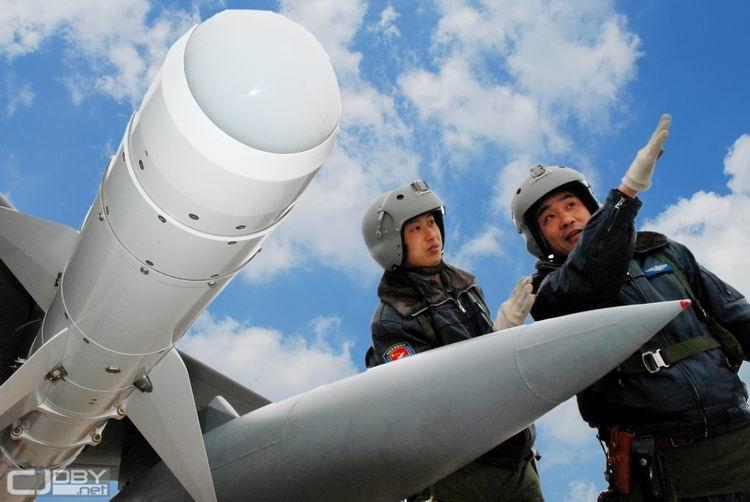The F-7MG airframe has essentially the same F-7P fuselage, inner wing portion, tail plane and fin. The outer wing section incorporates the major change, with a reduced 42° sweep and automatic manoeuvring flaps. The F-7MG is powered with an improved and more powerful WP-13 engine
Like the Su-15, the Draken J-35, as well as the more modern X-31 post-stall manoeuvring demonstrator, the F-7MG has a double-delta wing planform, which offers an excellent solution to a slender delta’s inherent low aspect ratio problem. The aspect ratio of conventional deltas is, at best, of the order of about 2.4, with the low end notched up, surprisingly, by India’s LCA; at 1.75 it stands behind the bat-winged double-delta Saab Draken, whose very low aspect ratio of 1.8 was considered to be a convenient remedy to the transonic CP shift, albeit at the expense of overall aerodynamic efficiency
Wingtip stalling has never been an issue on the F-7P, but the double delta wing brings with it an added bonus in this respect. The strong vortex of the inner wing re-energises the boundary layer of the outer wing, preventing span-wise flow towards the tips. This allows even more-carefree manoeuvring at ultra-low speeds.
On the first take-off, it was evident that the aircraft was impatient to get off the ground and had to be held down to prevent it getting airborne prematurely. Compared to the F-7P’s take-off speed of 310 kph, the MG lifted off at 280 kph with ease and the advertised 35% improvement in take-off distance was on the mark. The sight of the auto-manoeuvring flaps at work reminded the pilots of the F-16’s computer-controlled leading edge devices. Packaging the servo motors and actuators within the thin leading edge without the tell-tale bulges has certainly been a marvel of engineering at Chengdu Aircraft Corporation (CAC).
The feel of the aircraft was smooth in all domains, none more so than in transonic flight. As expected, CP shift was minimal and both the test pilots were unanimous about the decrease in stick forces. Transonic being an important combat flight regime, this is a welcome improvement.
A good measure of a wing’s lifting efficiency is at high alpha, a regime that the PAF pilots have learnt to perform in almost as an art form. What better than to pace the MG through a slow speed loop? Normally, a safe entry speed for a loop would be between 800-900 kph (at 15,000 AMSL) on the F-7P. In the absence of any guidelines on a slower version of the manoeuvre, it was decided to try 700 kph at first. The MG went through smoothly without any hint of judder or slip at the top. With full faith in the leading edge flaps, the next loop was performed at 600 kph. Again, the same results were achieved and the aircraft went through a perfect loop without any jitter or judder. At lower altitudes it might do even slower and better, but airspace limitations at Chengdu did not permit low level aerobatics.
Several flights followed the first check of the aircraft’s aerodynamic efficiency. It was a most pleasant surprise to note that the turn rates were nearer to the F-16 at medium to high altitudes and, were exactly as advertised. A 33% improvement over the F-7P at 5,000’ AMSL, 50% at 10,000’ and 66% at 20,000 would certainly call for an end to the “supersonic sports plane” sobriquet that dogged its forerunners.
The results of the flight trials were so encouraging that the test pilots were tempted to simulate a flamed-out engine landing pattern, a not very ‘done’ thing on delta-winged fighters. While the Chinese manuals suggested a rectangular pattern that can put one’s judgement and nerves to test, the standard overhead spiral pattern was tried out initially from a high-key height of 15,000’ AGL. With engine idling and speed brakes out to simulate a dead engine, the aircraft glided much like the F-16, so after a few approaches, the high key height was lowered to12,000’ AGL. The sink rate was well under control and, in fact was so well manageable that all later sorties were terminated through practice dead-engine approaches. At 1:8.5, the glide ratio compares favourably with some of the modern Western fighters.
The WP-13 engine of the F-7MG produces 1,200 lbs of more thrust than the F-7P’s WP-7, giving it a thrust-to-weight ratio of about .9 compared to .8 of the latter in clean take-off configuration. A 50% improvement in spool-up time is a welcome feature, particularly on final approach and landing where a sudden gust of wind has resulted in many a tail scrape on the F-7P. Go-arounds are also prompt and a bad landing is actually a thing of the past on the MG. Use of titanium alloys in compressor blades and an increased TBO are indicators of improvements in Chinese jet-engine technology.
The thrust increase was evidenced by a 25% improvement in acceleration time from 500 kph to 1100 kph and an equally impressive time-to-climb to 36,000’ AMSL. All improvements were verified and were found to be as advertised or even better. Even more remarkable was the fact that these trials took place in hot and humid weather, well outside the 15°C, 1013 hP environments in which the specifications are usually engineered.








 I suppose F-7 could be upgraded with BVR capability, but with JF-17 in full production, there is no need for such an upgrade.
I suppose F-7 could be upgraded with BVR capability, but with JF-17 in full production, there is no need for such an upgrade.